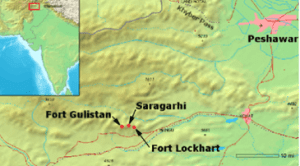TAG: GS 1: HISTORY (MODERN HISTORY)
CONTEXT: 12th September marks the anniversary of the Battle of Saragarhi fought between the British Indian Army’s Sikh Regiment and Afghan tribesmen.
EXPLANATION:
About the Battle of Saragarhi
- The Battle of Saragarhi was fought on 12 September 1897, in the then North-West Frontier Province of British India, (now in Khyber Pakhtunkhwa, Pakistan). The conflict was concentrated on Saragarhi garrison.
- The post was defended by 21 Sikh soldiers of 36th Sikhs regiment (At present- Indian Army’s 4th Battalion) of British Indian Army against soldiers of Pashtun, Orakzai tribes, more than 8 to 10 thousand in numbers.
- Led by Havildar Ishar Singh, the Sikhs fought to the last man, marking one of the greatest last stands in military history.
- The overwhelming difference in number and ratio of troop formation defending the post to the attackers makes it one of the rarest in history and unique in its own kind.
- The unit was led by Havildar Ishar Singh, who was commanding the post at the time of attack. He chose to fight valiantly, in the face of the inevitable, then to surrender.
Importance of Saragarhi:
-
- The British manned a series of posts, originally constructed by the great Sikh Emperor Maharaja Ranjit Singh during his Western campaign, along with the Hindu Kush ranges.
- The British later took these over. Saragarhi was a communication relay post between Fort Lockhart and Fort Gulistan (also known as Fort Cavagnari) in the Sulaiman Range of the NWFP.

Implication of the Battle
- The Sikh soldiers showed extraordinary courage, fighting against overwhelming odds.
- The 21 soldiers killed around 200 militants and injured 600, holding the enemy for seven hours.
- The British Government posthumously awarded all 21 soldiers the Indian Order of Merit.
- The battle highlighted the importance of discipline, leadership, and sacrifice, and underscored the role of Sikh regiments in the British Indian Army.
Significance of the Saragarhi Post:
- Saragarhi was crucial to ensure the survival of these two forts and for strategic defence of the region.
- Built by Maharaja Ranjit Singh, Saragarhi was a communication tower between Fort Lockhart and Fort Gulistan (Also called Fort Cavagnari). Later they were occupied by the British to guard the western frontiers and renamed.
- Saragarhi served as a link between the two forts, where large number of the British officers, families, and troops were stationed in the difficult terrain of the Sulaiman Range
- Saragarhi also served as a midway heliograph communication post for the two forts due to difficult geographical attributes, keeping them away from visual line of sight.
- Heliograph is a communication technique that uses sunlight for reflection via a mirror and transmits it through unique coded messages.
Source:
https://indianexpress.com/article/explained/explained-history/september-12-saragarhi-day-9563646/
Spread the Word
